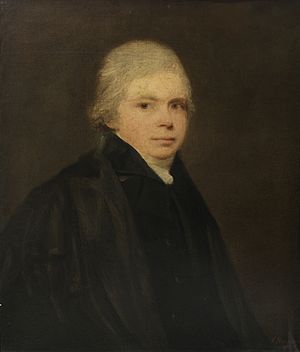George Smith Gibbes facts for kids
Sir George Smith Gibbes (1771–1851) was an English doctor and writer. He was known for his medical work, especially with the famous Bath Waters, and for being a physician to Queen Charlotte.
Contents
Life of a Famous Doctor
Early Life and Education
George Gibbes was born in 1771. His father, also named George Gibbes, was a church leader in Woodborough, Wiltshire. George went to the King Edward VI School, Southampton. After school, he studied at Exeter College, Oxford, and earned his first degree in 1792. He then became a fellow (a kind of academic member) at Magdalen College. He earned his medical degrees in 1796 and 1799.
Becoming a Respected Physician
In 1796, Gibbes was chosen as a fellow of the Royal Society. This is a very old and respected group for scientists. He joined the Royal College of Physicians in 1803 and became a fellow there the next year. In 1817, he gave an important speech called the Harveian oration at the College.
Dr. Gibbes worked as a doctor in Bath, Somerset. He was a well-known person in the city. In 1804, he became a doctor at the Bath Hospital. Later, he became a special doctor to Queen Charlotte. In 1820, George IV made him a knight, so he became "Sir George." He also helped with city business in Bath until 1834.
In 1835, Sir George Gibbes stopped working as a doctor. He moved to Cheltenham. He passed away in Sidmouth on June 23, 1851, when he was 80 years old.
Sir George's Writings and Discoveries
Sir George Smith Gibbes wrote several important books and papers. His main works included:
- Treatise on the Bath Waters (1800), which was about the special waters in Bath. He wrote a second part in 1803.
- Pathological Inquiries, or an Attempt to Explain the Phenomena of Disease (1818). This book tried to explain how diseases work in a way that people could understand.
He also wrote other papers, such as:
- An essay in the Philosophical Transactions in 1794. This was about how muscle could change into a substance like spermaceti.
- A guide for chemistry lectures he gave in Bath in 1799.
- A Phlogistic Theory ingrafted upon M. Fourcroy's "Philosophy of Chemistry", part 1, in 1809.
- A speech he gave at the opening of the Bath Literary and Philosophical Institution, published in 1825.
Sir George was also a fellow of the Linnean Society, which is a group for natural scientists. He wrote about a bone-cave he explored in the Mendip Hills. This was one of the first bone-caves studied in England. He also wrote articles about the Bath waters and other chemistry topics for Journal of Natural Philosophy by William Nicholson. He wrote a "Description of the Diacatoptron" for Philosophical Magazine.
Family Life
Sir George Gibbes was married two times. His first wife was the daughter of Edward Sealey from Bridgwater. She passed away in 1822. In 1826, he married Marianne, who was the daughter of Captain T. Chapman.


